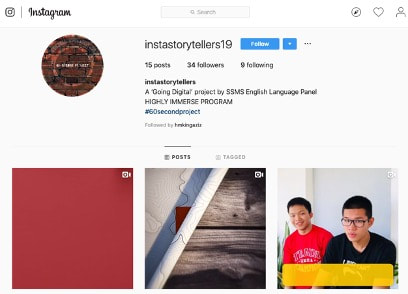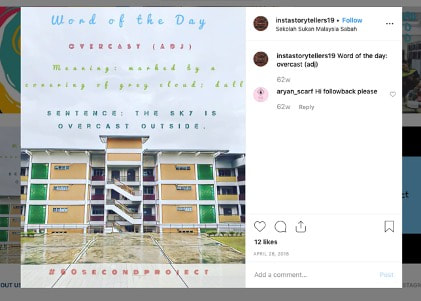|
by Abdul Aziz bin Arsyad
Summary
Truth be told, when a new programme intended to improve students’ language performance is introduced to be executed in schools, most of the effort will come from teachers. This was precisely what transpired when the latest move by the Ministry of Education to introduce Highly Immersive Programme (HIP) in schools was initiated in 2016. This article aims to look at an initiative called The 60-Second Project done at Sabah Malaysian Sports School and the possibility of it encouraging students to be self-driven instead of being coerced to take part. The 60-Second Project involves several technological platforms in its implementation including video-making apps and WhatsApp to reach out to every member of the school and all students’ parents. Although the implementation of the 60-Second Project is still ongoing, it can be observed thus far that students’ involvement and motivation are higher as compared to the old ways of conducting English language-related activities.
Background and Context
Highly Immersive Programme (HIP) was first introduced in 2016 as a part of the effort by Ministry of Education Malaysia to increase the mastery of English language among students and to widespread the use of the language beyond the four walls of the classroom. This programme, that is a fraction of MBMMBI Policy, uses whole-school approach and outreach concept. The whole-school approach consists of three types of activities- in-class, out of class and extra class. As an effort to carry out this programme, my English panel teachers and I devised a few activities as part of the HIP. Some of the activities were A Word A Day and Book Review that would be conducted during our formal assembly in English. It was good while it lasted, but it proved hard to sustain the interest. Months later, the students would no longer write a word on the board unless they were made to. One word would stay on the board for weeks, betraying the name of the programme. Even if they did, the word would often go unnoticed. As for the book review, the students became too dependent on the teachers to provide the texts for them to read out loud mindlessly during the assembly. As the head of the English Language Panel in my school, the spiraling motivation of the students to engage in the Highly Immersive Programme (HIP) activities broke my heart the most. Every now and again, I would grab one student who was unlucky enough to pass by in front of the board and shove a marker and a dictionary into his or her hand. Deep down, I knew that it was a one-way street. The students did not even meet me halfway. However, whenever my students were on social media like Facebook and Instagram, they would use English voluntarily. On their constantly-updated Insta Story -the latest feature of Instagram- the students would post videos, pictures and Boomerang that would contain English captions, albeit various glaring errors. This observation led me to an epiphany - to integrate technology in the implementation of several Highly Immersive Programme (HIP) activities. Since teenagers today are into vlogging and video-making, it dawned on me that perhaps manipulating this inclination could help them be more involved voluntarily. That was how the 60-Second Project was born. Introduction - The Planning Stage Wait a minute! Just a minute? The epiphany led me to devise a digital approach that would encourage my students to be voluntarily involved in several Highly Immersive Programme (HIP) activities. However, there was another tumbling block - time. Since my students were aspiring young athletes who would go out competing in various tournaments on almost weekly basis, I knew time would be a major factor. They barely had time to juggle between their books and balls, let alone making videos. This would sound too daunting for the students. Thus, limiting the duration of the videos to only 60 seconds certainly would give them the confidence that this project was doable and viable within their academic and sports constraints. Objectives This project was initiated with the following objectives in mind:
Project Question Will my students and I be able to change the conventional way of implementing Highly Immersive Programme (HIP) activities and infuse technology to reach out to all stakeholders of the school and perhaps beyond? Development Methodology As this project is still at the early stages of its implementation, the methodology used in this project is limited to observation and students’ responses and feedback while working on their videos. Our Little Committee The 60-Second Project kicked off when I casually pitched the idea in the classroom to my students in Form 3, 4 and 5. Some were skeptical, some were fence-sitters but a couple of hands eventually shot up in the air. The following Saturday, we had our first the 60-Second Project Committee Meeting. In my first committee meeting with my little co-project managers, we discussed the possible topics to be talked about in our videos and the usual do’s and don’ts to ensure that the students would not touch issues considered taboo and sensitive. In the end, six topics were shortlisted. They were: 1. Word of the Week 2. Book of the Week 3. Idiom / Proverb of the Week 4. Athlete of the Week 5. Issue of the Week 6. Mistake of the Week Once the topics were finalised, the students then embarked on their video-making adventures. Implementation Not too fast! No advanced gadgets allowed! While the students were not restricted to be creative and edgy with the content and editing process of their videos, several ground rules were set. Firstly of all, the students were reminded that only smart phones were allowed to be used in the process of recording their videos. This ruled out the possibility of using more advanced gadgets including DSLR cameras. The rationale behind this somewhat peculiar rule was to ensure that all students were on level-playing field. However, the main reason of this restriction was because smart phones were an easier alternative. Most students in my school owned one even if they were prohibited to be in possession of one according to the school rules. Another ground rule pertinent to the process of video making for the 60-Second Project was the students were only allowed to use apps available on Google Play or Apple Store for editing purposes. Again, any advanced software installed on computers or laptops was prohibited. Nevertheless, the students were given complete freedom to use any apps available for the editing process because deep down I knew they were better explorers when technology was concerned. I would not want to make a fool out of myself by suggesting apps that could have been less fancy or, God’s forbid - obsolete - when the students might have been exposed to better, more revolutionary apps. At the end of the day, all I wanted to show them was that they did not have to fork out big bucks to contribute to the project. A basic smart phone with several apps downloadable for free from Google Play or Apple Store would suffice. After all, isn’t less more? And only a 60-second long video? How hard could that be? Juggling three roles: Students, athletes and video-makers It was hard. A basic smart phone, a few free editing apps on Google Play and Apple Store and a 60-second duration requirement still proved to be a challenge for my students. Initially, two weeks were given to the students to work on the pilot project. Upon observation and enquiry, my students still found the project quite a mountain to move despite their interest to voluntarily be involved in the project. Time was still the biggest, most prevalent factor. Between the intense daily training and the pressure to perform academically, the students had little time to be engaged in the project since I did not allocate specific time in or off the classroom to work on their videos. So I extended the due date of submission. From a couple of weeks, it became a month. I kept reminding myself that patience was a virtue. Soon enough, over the weekend, I received one video via WhatsApp from one of the project pioneers. A couple of minutes later, another came in. And it snowballed until I received videos from all the project pioneers! The whole process of making videos for the project took approximately 5 weeks with no specific time allocated for the students to work on it. In the 6th week, my students and I had a brief video-watching session and discussion pertaining to the videos they had created. During the video-watching session, each student explained what went into the process. They talked about the various apps they used, the editing techniques applied and the stumbling blocks along the way. There was one thing that I did not foresee to take place during the video-watching activity and that was impromptu Q&A session. Some students who were impressed with the videos made by their fellow project pioneers began to seek clarification on how certain features were integrated in the videos. Then discussion took its place without being formally initiated by me. Reflection Teacher: What the students have taught me Based on the pilot videos that have been produced by the students for the 60-Second Project, I admit in all humility that the students have taught me more that what I intended them to learn through the project. Being in an examination-oriented education system, it is easy to overlook the need to integrate technology in the implementation of teaching and learning as well as English-related programmes in favour of chalk and talk and conventional approaches to conducting language activities. What is even easier is to come up with excuses. Contrary to skeptical beliefs, with the right mindset and approach, integrating technology in teaching and learning and beyond the four walls of the classroom helps elevate some burdens off teachers’ shoulders. The main reason for this is that technology provides opportunities for students to be autonomous and self-driven. All students need is just a little nudge and motivation and wonders become inevitable. . Students: What they have learned Despite all the different shoes that they had to wear on daily basis, the students managed to complete the pilot videos for the 60-Second Project. The students admitted that after the video-showing session, they still had a long way to go in terms of producing quality videos for the Highly Immersive Programme (HIP). Nonetheless, the students noted that the project allowed them vast opportunity to be creative and expressive in a way that spoke volumes about who they were individually. It was also a welcomed from the traditional ways of conducting language-related activities that were predominantly dull and cringe-worthy. Revision - What’s Next? The 60-Second Project Headquarter and Reaching out Since the 60-Second Project is still at the initial stage of its implementation, my students and I have learned tremendously from the pilot videos produced. Moving forward, we have several improvements in plan. One of our major plans is to make full use of the recording room that we have in our language lab and turn it into our headquarters for the 60-Second Project! With the allocation that we have received from PADU to aid the implementation of Highly Immersive Programme (HIP), we plan to equip our recording room with basic necessities for better recording quality. In line with one of the objectives of Highly Immersive Programme (HIP), my students and I wish to reach out to every member of the school including parents and other learners out there. The videos that the students will produce in the future will be shared on digital platforms including the official Parent-Teacher Association (PTA) WhatsApp group, Facebook and another possible digital educational platform I am currently exploring called Edmodo. Borrowing a quote by John Green from his critically-acclaimed novel The Fault in our Stars, he says “I’m on a roller coaster that only goes up”. That’s the only option that my students and I have from here onwards - go up.
References / Useful Links
To learn more about Highly Immersive Programme (HIP) by the Malaysia Ministry of Education, go here. Published on: 31 October 2020 AuthorAbdul Aziz bin Arsyad has served in the field of ELT in Malaysia for close to ten years. He wrote this article when he was the Head of English Panel for the Sabah Malaysian Sports School in Kota Kinabalu before flying off to Scotland to pursue a MSc in TESOL at the University of Edinburgh as a Chevening Scholar. He is now working as an ESL lecturer at the Malaysia Institute of Teacher Education Tawau Campus. He can be reached at [email protected]
Want to write for us? Send us a message!
0 Comments
Leave a Reply. |
Categories
All
|



